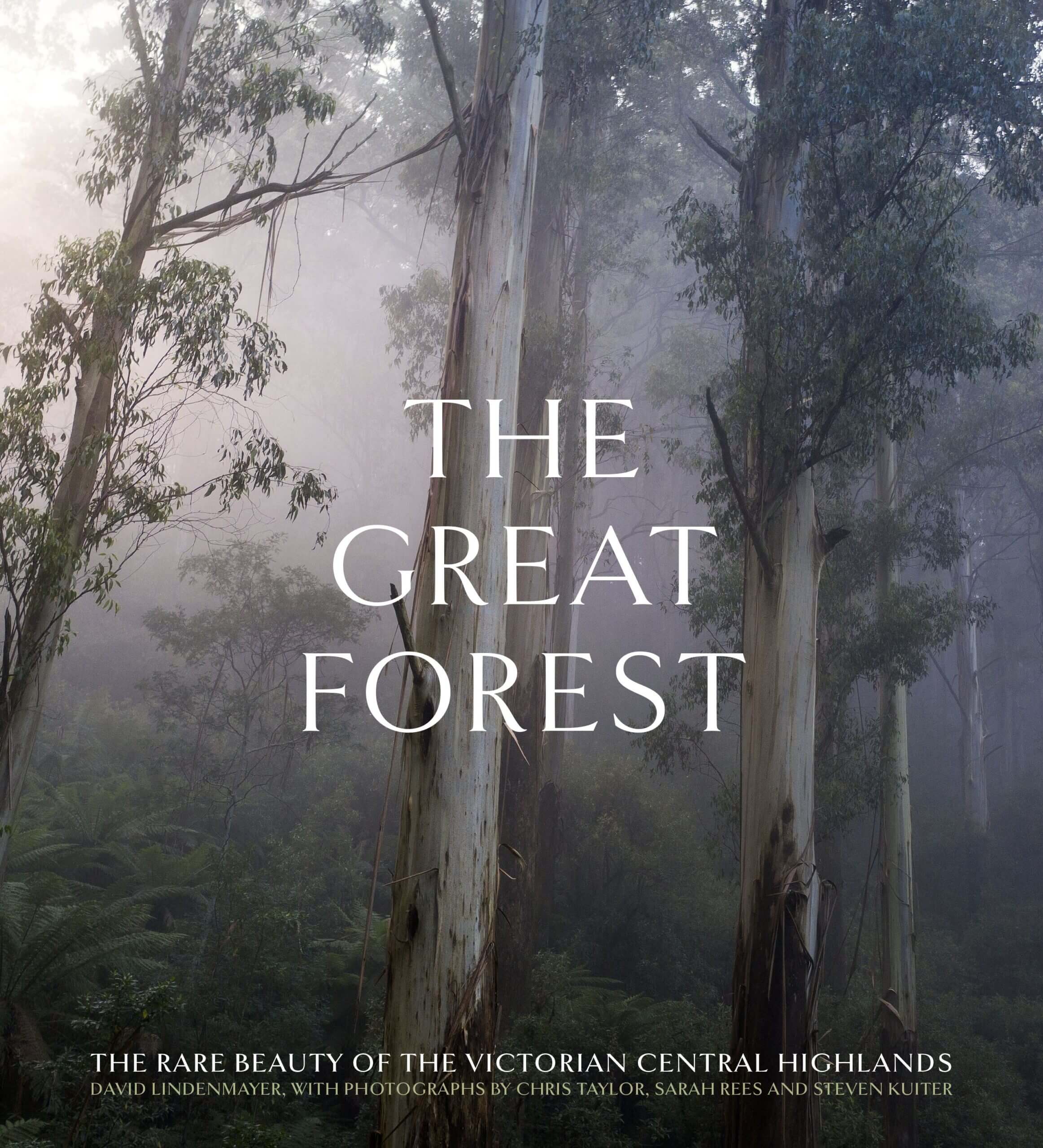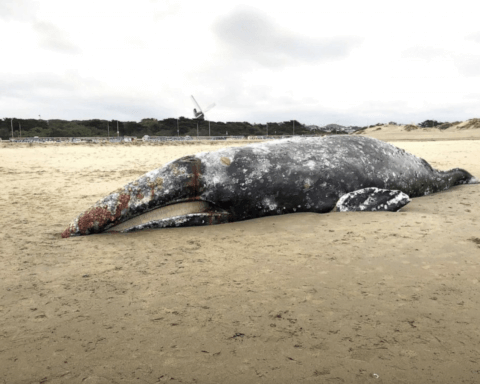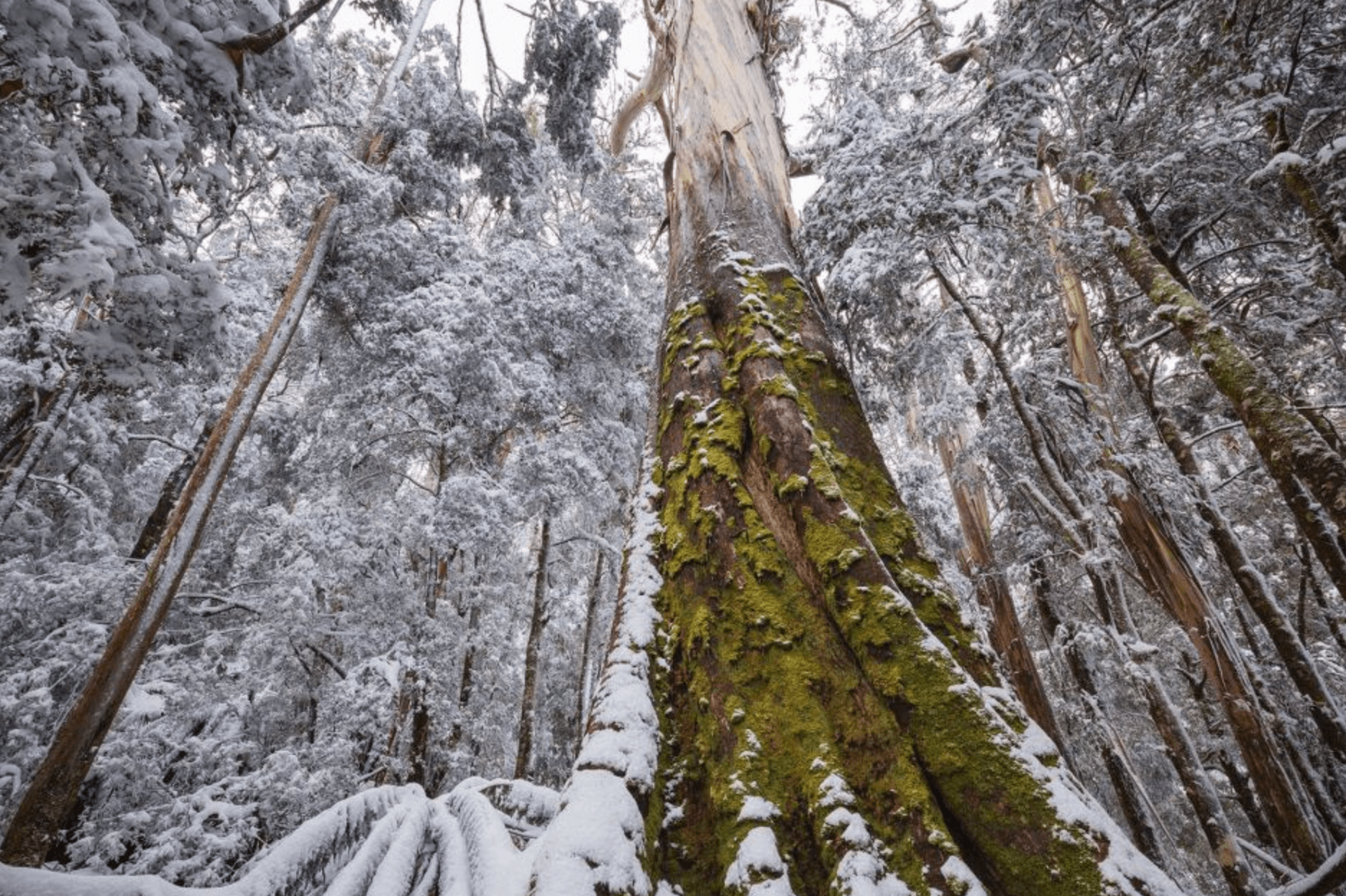The Great Forest is a stunning book that is loaded with intriguing information and many beautiful images.
Ecologist David Lindenmayer along with photographers Chris Taylor, Sarah Rees and Steven Kuiter have presented the finest tabletop forest book that I have ever read.
These skilled Aussie forest defenders help us understand the mesmerising wet forests of Victoria’s ancient Central Highlands, and that the Indigenous Peoples are the rightful caretakers of these lands. This exquisite book showcases the majestic oxygen-making mountain ash, the world’s tallest flowering trees and many of its unique animals.

Mountain ash is an extremely fast growing eucalypt. They add one metre (3.3ft) a year for the first 50 years of life. These tall ones can easily reach 90 metres (295ft) and some perhaps even 100 metres (328ft) towards heaven’s gate. They live for hundreds not thousands of years because Australia is a fiery continent.
As these mountain forests age, each year they shed tons of bark. That bark is vital habitat for tree crickets and spiders, important prey for possums, gliders and birds.
Seventy species of bird life inhabit the Central Highlands forests. The languages of the birds are awe-inspiring. The diversity of species, in fact, reveals much about the health of the forests.
Although rare and endangered birds are important, Lindenmayer explains that common bird species do the ‘heavy lifting’ in maintaining a number of critical forest ecological processes, including pollinating, seed dispersal and turning over forest floor litter, which affects decomposition rates. For example, the superb lyrebird, which mimics to a T every noise it hears, turns up 150 tonnes of leaf litter and soil each year, each bird, in search of food. These feathered caretakers speed up decomposition of organic matter that might otherwise be fuel for wildfires.
The wet forest understory is fascinating too. There are downed tree trunks that act as runways for mountain brushtail possums, nesting sites for brushtail rats and shelters for venomous tiger and highland copperhead snakes. It’s also home to the world’s tallest moss, Dawsonia, which stretches an astounding 50 centimetres (20in).

Tree ferns are older than dinosaurs.
These incredibly hardy plants are often the first to show signs of recovery after a bushfire.
Tree ferns that could be 1000 years old and daisy bushes often dominate the understorey of mountain ash forests. The forest floor is a tremendous carbon warehouse. Acacia, nature’s fertiliser trees, hide some seed within the topsoil for up to 100 years, waiting patiently, for fire and a chance to germinate.
Acacia leaves and seeds are an essential food source for mountain brushtail possums. The sap is a vital supply of carbohydrates for the critically endangered leadbeater’s possums and sugar gliders. Leaves are consumed by insects and, in turn, preyed upon by possums, gliders and birds. Ah, the circle of life!
Fungi and termites, we learn, have an essential role in these marvelous wet tree cities. They create cavities in trees. Australia is the only forested continent that lacks woodpeckers. Hence the formation of cavities is a much slower process than in forests of other parts of the world. It takes decades or centuries in Aussie trees.
Surprisingly, these spellbinding wet forests support more cavity-dependent species than anywhere else on Earth. More than 300 species of mammals, birds, reptiles, frogs and thousands of kinds of insects all rely upon cavities within big trees to eke out an existence.

The dripping mountain ash forests provide nearly all the water for the megalopolis of Melbourne, which has some of the best drinking water on the globe. Lindenmayer reminds us that old-growth forests generate up to 12M litres (3.2M gal) more water per hectare (2.2ac) each year than young forests. Two-thirds of the Thomson Catchment, Melbourne’s water supply, comes from glorious forests dominated by mountain ash.
We discover that more than 98 per cent of these forests are 80 years old or younger. Subsidised, crazed, money-losing, logging has decimated these shrines. The one per cent or so that remain are scattered across more than 100 sites. Ladies and gentlemen, these irreplaceable cathedrals are so worthy of immediate and total protection from chainsaws and bulldozers.
A breathtaking network of rivers and streams within the Central Highlands gives rise to sublime waterfalls. The images inside The Great Forest are gorgeous. It’s all about freshwater because freshwater is life.
Australia is the most fire-prone continent in the world and almost all plant species respond to fire in different ways.
Man-made global heating is driving more frequent and widespread climate fires. The 2019-2020 climate fires in Australia were unprecedented. They razed 12.3M hectares (30.4M ac) and cremated more than three billion individual animals. Some of that scorched 2019-20 area had burned two or three times in the previous 25 years, including places that should normally burn only once every 75-150 years.

The health of the great forest depends upon the health of the wildlife. Greater gliders are ‘sentinel species’. That is, the condition of the population indicates the condition of the forest. This species is sensitive to land clearing, logging, fire and global heating. The catastrophic decline of the greater glider is the last wake-up call to protect the remaining mountain ash wet forests.
In 2019-2020, logging Victoria’s state-owned forests lost $20M. Moreover, $24M in forest subsidies were handed to the loggers . . . Turning these breathing, dripping, carbon-inhaling mountain ash titans into cheap paper and single-use cardboard is the crime of all crimes, especially since Australia has enough wood growing in farms to meet both its domestic and international marketplaces.
Recently, Premier Daniel Andrews’ government changed the laws to enable logging on high elevation and steep slope forested sites. A classic in-your-face timber grab. Andrews just invested in extinction. Planet-killer.
After immersing yourself in The Great Forest, all you want to do is go and see it for yourself, and then join the forest blockades to end senseless destruction. Once and for all, let’s safeguard the Central Highlands and its rare and inestimable pockets of forested biodiversity.
This exceptional book belongs on everyone’s tabletop. It’s the perfect holiday gift.
I congratulate Lindenmayer, Taylor, Rees and Kuiter for bringing these extraordinary carbon storehouse wet forests and their remarkable kith and kin, the animals, to the attention of everyone so that we may rally and rejoice in their protection.
The people have spoken, it is time to heed their call for The Great Forest National Park!
Agitate, Disrupt. Defend.
#CutCarbonNotForests
#TheGreatForestNationalPark
#LoveNature
#ZeroCombustionEconomy
#BeeKind
#GoVegan
#TheGreatForest
#GenZEmergency

Reese Halter is a bees/trees/seas defender.
His latest book is GenZ Emergency.
Email: HalterBooks@gmail.com for your autographed copy.
In Australia, order from the Bob Brown Foundation by emailing: Contact@BobBrown.org.au














